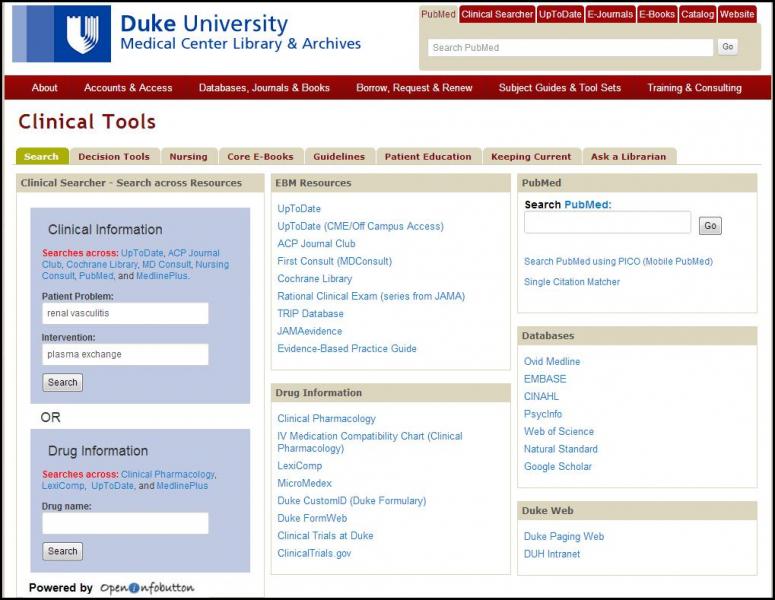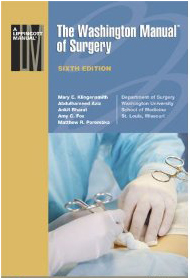 Exhibit Now on Display!
Exhibit Now on Display!
This month, the Medical Center Library & Archives celebrates over 80 years of serving Duke medical students and faculty. An exhibit, "Today’s Challenge, Tomorrow’s Promise," is now on display chronicling the important people, events, and technology that have made the Library a leader in providing access to medical information.
The exhibit will be on display from February - July 2013 on Levels 1, 2 and 3 of the Library.
New Neighbors - More Changes!
Pat Thibodeau, Associate Dean for Library Services & Archives
The opening of the Mary D.B.T. Semans Center for Health Education has been wonderful for the Medical Center Library & Archives, as well as the School of Medicine! We have gotten to know more colleagues within the School, as well as seeing colleagues on a daily basis that we've known for years. What is just as exciting is the wonderful flow of all type of students, faculty, and staff back and forth between the Mudd and Semans buildings. We have really become integrated with almost seamless facilities. We congratulate the School of Medicine on this wonderful new educational facility!
The Library has created a small tribute to Mrs. Semans for her many years of support, as well as an extensive look at our history from 1927 to the present, starting in the Davison building and ending up in the Mudd Library facility and Christian Avenue location for Archives. Please visit our exhibit, "Today’s Challenge, Tomorrow’s Promise," which focuses on technology, and changes in our services, resources, and our facility.
Big changes in February!
The lobby walls have been taken down, so there is no longer a divider between the elevators!
The elevators now run to every floor, though there may be restrictions to some levels at night and on weekends to ensure security of other departments’ spaces on Level 0 and Level 4.
24-hour access to the Library using Duke Medicine ID badge
Card access all other hours for Duke Medicine faculty, students, and clinical staff with ID badges
Due to security concerns, the Reading Room and Book Collections will be available during limited hours: Monday-Friday: 8 am -12 midnight; Saturday: 12 noon - 8 pm; Sunday: 12 noon - 12 midnight
Other changes in the Library facility!
The floor level designations have changed!
Level 1 (Administration, Computer Classroom, Book Collections and Reading Room)
Level 2 (Main Entrance, Service Desk, Computer Stations)
Level 3 (Study Space and Journal Stacks)
New group study space off the Reading Room (102B)
Cell phone service upgrade expected later in February
New furnishings on Level 3, with new workstation chairs on Learning Center Level 2. Check out our bright colors and more modern chairs, tables, and “scooches” (look like footstools, but with handholds for scooching closer to the chairs and tables)
New colors on Level 1 and Level 3, making those areas brighter and more appealing
Portraits, busts, and plaques recognizing Duke leaders, events, and history of medicine scattered throughout the Reading Room and the Library
EXPLORE: Tools to Improve Your Research, Teaching & Work
Leila Ledbetter, Research & Education
PubReader
Reader-friendly view of articles in PubMed Central!
The National Library of Medicine has released a new tool called PubReader to help users access the full text of articles in PubMed Central (PMC), a publicly available archive of biomedical and life science journal articles. PMC includes more than 2.6 million articles that anyone can access.
PubReader is a new format specifically within PMC that allows users to easily navigate within an article, viewing images, flipping through pages, and more. It was designed particularly for enhancing readability on tablet and other small screen devices, but it can also be used on desktops and laptops and from multiple Web browsers.
Scientific papers most often appear on the Web as a single long page that you read by scrolling through vertically. This makes it difficult to navigate inside the document. If you scroll back to look at an image or a figure, you may easily lose your place and have to hunt around for the spot where you stopped reading.
To improve readability and navigation, PubReader breaks an article into multiple columns and pages, similar to a printed paper. It allows you to adapt a page to whatever fits on your screen — whether it be multiple columns on a desktop monitor or a single column page on a small tablet. When you adjust the font size or change the size of the browser window, page boundaries and columns are adjusted automatically.
The new view is available for any PMC article in full-text HTML form. It can not be used to view older content available o nly in PDF format or for scanned images of the original print pages.
nly in PDF format or for scanned images of the original print pages.
You can get to the new view directly from an article citation in a search results list or an issue's table of contents.
It can also be accessed from the Formats link in the top right corner of an article page.
For more information about PubReader, consult the PMC Website.
Save Time with the Clinical Searcher!
Connie Schardt, Associate Director, Research & Education
Clinical Searcher
http://guides.mclibrary.duke.edu/clinicaltools
The Clinical Searcher is a tool that allows you to search simultaneously across a number of important resources:
Clinical Information
UpToDate, ACP Journal Club, Cochrane Library, MDConsult, Nursing Consult, PubMed and MedlinePlus
Drug Information
UpToDate, Clinical Pharmacology, Lexicomp, and MedlinePlus

The results page will first show the hits for UpToDate, since it is the first resource in the list. A simple click on any of the other resources (left navigation) can show additional results for your search in a new window.
Clinical searcher uses the OpenInfobutton protocol and can be configured for integration into the electronic medical record.


For more information, contact Connie Schardt at connie.schardt@duke.edu.
New Engel Books
Karen Grigg, Collection Development Services
These books are part of the Library’s special collection established in memory of Dr. Frank Engel, who always thought students should have other reading sources that took them beyond their medical studies. These reviews are excerpted from Amazon.com.
 Drugs for Life: How Pharmaceutical Companies Define our Health
Drugs for Life: How Pharmaceutical Companies Define our Health
Every year, the average number of prescriptions purchased by Americans increases, as do healthcare expenditures, which are projected to reach one-fifth of the U.S. gross domestic product by 2020. In Drugs for Life, Joseph Dumit considers how our burgeoning consumption of medicine and cost of healthcare not only came to be, but also came to be taken for granted. He has concluded that underlying the continual growth in medications, disease categories, costs, and insecurity is a relatively new perception of ourselves as inherently ill and in need of chronic treatment.
 The Signal and the Noise: Why So Many Predictions Fail - but Some Don’t
The Signal and the Noise: Why So Many Predictions Fail - but Some Don’t
Nate Silver predicted the 2008 election within a hair’s breadth, built an innovative system for predicting baseball performance, and became a national sensation as a blogger, all by the time he was thirty. The New York Times now publishes "FiveThirtyEight.com," where Silver is one of the nation’s most influential political forecasters. Drawing on his own groundbreaking work, Silver examines the world of prediction, investigating how we can distinguish a true signal from a universe of noisy data. In keeping with his own aim to seek truth from data, Silver visits the most successful forecasters in a range of areas, from hurricanes to baseball, from the poker table to the stock market, from Capitol Hill to the NBA. He explains and evaluates how these forecasters think and what bonds they share.
Hallucinations don’t belong wholly to the insane. Much more commonly, they are linked to sensory deprivation, intoxication, illness, or injury. Here, with his usual elegance, curiosity, and compassion, Dr. Oliver Sacks weaves together stories of his patients and of his own mind-altering experiences to illuminate what hallucinations tell us about the organization and structure of our brains, how they have influenced every culture’s folklore and art, and why the potential for hallucination is present in us all, a vital part of the human condition.
 A Man of Misconceptions: The Life of an Eccentric in an Age of Change
A Man of Misconceptions: The Life of an Eccentric in an Age of Change
This is the vivid, unconventional story of Athanasius Kircher, the legendary seventeenth-century priest-scientist who was either a great genius, a colossal crackpot, or a bit of both. Kircher’s interests knew no bounds. From optics to music to magnetism to medicine, he offered up inventions and theories for everything, and they made him famous across Europe. His celebrated museum in Rome featured magic lanterns, speaking statues, the tail of a mermaid, and a brick from the Tower of Babel. With humor and insight, John Glassie returns Kircher to his rightful place as one of history’s most unforgettable figures.
Suggestions for purchases? Complete our online Recommend a Purchase form or contact Karen Grigg. For a complete list of titles added to our book and ebook collections within the last 3 months, check out the Library's newest book additions or subscribe to our "New Books" feed.
DUMC History Retrospective: Integrating Medicine
Matt Shangler, Assistant Archivist, Medical Center Archives
This year marks the 50th anniversary of the first African-American students admitted to Duke University. In the fall of 1963, the first five African-American undergraduate students enrolled, effectively integrating the school. But what about the School of Medicine?
Like most hospitals and institutions in the south before 1960, Duke Hospital and School of Medicine had a policy of racial segregation. The hospital wards and employee facilities were segregated and African Americans were not admitted to the School of Medicine. While faculty tried to change the policies in the 1950s, it was difficult to do so when internal and external social pressures were calling for continued segregation. However, by the turn of the 1960s, the racial policies at Duke began to change with pressure from multiple sides.
In November 1960, Barnes Woodhall, newly appointed Dean of the School of Medicine, wrote a memo calling for the integration of the School of Medicine:
“It is my opinion that continuation of the existing segregation policy of the University will seriously impair the ability of the Medical Center to further its traditional duty of ‘caring for the sick’ and may eventually destroy its credo of excellence…I request that the University admit properly qualified members of the colored race to its graduate and professional schools.”[1]
In April 1961, the board of trustees voted to integrate all graduate and professional schools. In August, the consulting firm of Booz, Allen, and Hamilton issued their report on Duke Hospital which concluded that Duke Hospital not only needed new facilities, but also private rooms for African-American patients.[2] But Duke didn’t wait for the report to come out before changing hospital policies. By August, Duke Hospital had integrated all of its waiting rooms and employee locker rooms, and began hiring hospital personnel without regard to race, religion, or national origin.
With the exception of the VA Hospital, Duke was one of the first medical institutions in North Carolina to desegregate. Dr. Ed Halperin noted in his article, “Desegregation of Hospitals and Medical Societies in North Carolina,” that at Duke, “The basic science faculty, with a large portion of northerners, pressed for integration.” Despite a failed attempt in 1956 to desegregate the wards, Duke integrated its hospital and medical school earlier than other institutions in North Carolina and with far less resistance from its faculty, staff and students. By comparison, for example, segregation was first challenged at Cone Hospital in Greensboro in 1961, and later by nine black physicians in 1962. However, the suit filed against Cone Hospital dragged on in the courts until a ruling by the U.S. Court of Appeals in favor of the black physicians was made final when the Supreme Court declined to hear the case in 1964.[3]
While not challenged in the courts, segregation at Duke was contested among its faculty and staff in various ways. In 1959, Dr. William S. Lynn, Jr., a southerner, decided to erase the ‘whites only’ wording off the bathroom doors in the Bell Building in order to provide more bathroom facilities for the black staff. Dr. Joseph Beard, who largely funded the building’s construction, became furious and ordered the words be repainted. Lynn kept removing the words as quickly as Beard could have them repainted. None of the faculty would identify Lynn as the perpetrator. This act of defiance continued into 1961 and did not cease until Beard eventually gave up the fight.[4]
Real change came to Duke with the arrival of Wilhelm Delano (Del) Meriwether in 1963 (pictured above). Born in Nashville, Tennessee, and raised in Charleston, South Carolina, Meriwether attended Michigan State University where he graduated in just three years. When applying to medical schools, his father urged him to consider Duke. Under its new admissions policy, Duke had begun recruiting African-American applicants to the School of Medicine. After an initial hesitation, Meriwether applied and flew down to Duke for an interview in the spring of 1963. Rather than be turned away by the still present signs of segregation in the Durham community, Meriwether became determined and decided to enroll as the first African-American medical student at Duke.[5]
Meriwether went on to receive his MD in 1967 and to complete an internship at the University of Pennsylvania before doing his residency at Ohio State University. Meriwether also became an accomplished runner, setting a record 6.0-second 60-yard dash in the winter of 1970-71 . He later won the 1971 national Amateur Athletic Union (AAU) 100 yard dash, which garnered him a cover of Sports Illustrated.
Professionally, Meriwether worked in a hospital ER in Washington, DC, from 1978 to 1983 and as a missionary doctor in South Africa from 1984 to 1990. Since returning to the United States, he has continued to work in emergency rooms in Pennsylvania and Maryland.
For more information, please contact Medical Center Archives at dumc.archives@mc.duke.edu or 919.383.2653.
______________________________________________________________________________________________________
[1] Memo on Integration Policy, 20 November 1960, Barnes Woodhall Papers, Box 6, Medical Center Archives, Duke University, Durham, North Carolina
[2] Walter Campbell. Foundations for Excellence. Durham, Duke University Medical Center Library. 2006. p. 282
[3] Halperin, EC. “Desegregation of hospitals and medical societies in North Carolina.” New England Journal of Medicine. 318 (1988): 58-63
[4] Halperin, EC. “A Solitary Act in the Bell Building: Striking a Blow for Racial Desegregation at a Southern Medical School.” Pharos Alpha Omega Honor Med Soc. 2.70 (2007): 48-51
[5] Transcript, Wilhelm Delano Meriwether Oral History Interview, March 7, 2008, by Jessica Roseberry, Duke Medical Center Archives
NIH Public Access Compliance Update
Emily Mazure, Biomedical Research Liaison Librarian

The National Institutes of Health (NIH) recently released a new Notice that affects all NIH funded researchers at Duke.
NIH is now requiring that all institutions are compliant with the Public Access Policy. NIH will delay processing of non-competing continuation grant awards with a start date of July 1, 2013 or beyond, if your publications are NOT compliant. See the full policy at http://grants.nih.gov/grants/guide/notice-files/NOT-OD-12-142.html.
As the noitce indicates, all NIH grant-related publications need to be deposited into PubMedCentral (PMC) within 3 months of the official publication date, otherwise they will be flagged as non-compliant by NIH. For details on the various ways to submit your peer-reviewed articles, visit our NIH Public Access Policy Compliance Guide. Library staff are available to offer help to researchers and their staff as they manage compliance.
You will need to create and use a My NCBI account (part of PubMed) allowing you to:
- Link your My NCBI account to your eRA Commons ID and password
- Build a bibliography of grant related publications
- Link publications to grants
- Identify what is and is not in compliance – NIH provides you with updates
- Notify NIH when an article is not covered by the policy
- Submit your bibliography for your Research Performance Progress Report
- Share your publications with the PI and even fellow researchers
- Appoint a designate to help keep your citations current and in compliance
For more basic information, our NIH Public Access Policy Guide covers the following:
- Introduction to the Policy
- Basic instructions for determining what publications fall under the Policy
- How to demonstrate compliance using My NCBI
Emily Mazure, Biomedical Research Liaison Librarian, is also available to answer questions or provide instruction for groups (emily.mazure@duke.edu; 919.660.1197).
Featured New E-Books
Karen Grigg, Collection Development Services Librarian
Here are some of the new e-book titles that have been recently added to our collection.
Since 1997, The Washington Manual of Surgery has consistently provided residents with need-to-know surgical information and guidance in a convenient and easily accessible source. Each chapter has been updated and revised by a resident with assistance from a faculty coauthor from the Department of Surgery at one of the world’s top surgical training programs. The Manual’s unique perspective gives readers a clear view of the challenges surgical residents face, and of the practical solutions they have seen work, first hand.
Now in its Sixth Edition, The Washington Manual of Surgery continues to deliver a concise, rational approach to the management of patients with surgical conditions. The text has been redesigned to make it even more user friendly, and the content has been updated with the latest advances in surgical technique and instrumentation.
 Medical Physiology: A Cellular and Molecular Approach
Medical Physiology: A Cellular and Molecular Approach
Quickly review important content using prominent boxes included throughout the text that provide clinical examples of disordered physiology
Master difficult concepts with the use of 800 color drawings featuring balloon captions explaining key processes
Find information easily with the intuitive organization by body system and consistent style
Get current coverage of physiology with updated material including text and figures, a new chapter on Physiology of Aging, and a new section on hemostasis
Easily relate molecular and cellular biology to the study of human physiology and disease
Suggestions for purchases? Complete our online Recommend a Purchase form or contact Karen Grigg. For a complete list of titles added to our book and ebook collections within the last 3 months, check out the Library's newest book additions or subscribe to our "New Books" feed.
Staff News
 Leila Ledbetter, Research & Education, has been elected Secretary and appointed as Archivist for the Association of North Carolina Health and Science Libraries (ANCHASL).
Leila Ledbetter, Research & Education, has been elected Secretary and appointed as Archivist for the Association of North Carolina Health and Science Libraries (ANCHASL).
Beverly Murphy, Communications and Web Content Management, has been appointed to the role of Webmaster for the Association of North Carolina Health and Science Libraries. She also serves at the Association's Advisor.
Improve Your Library Research Skills!
The Medical Center Library & Archives offers training on a variety of topics. Sign up for an upcoming class, customize your own, or schedule an appointment for a research consultation.
Publication Schedule & Staff
Duke University Medical Center Library & Archives News is published bimonthly.
| Pat Thibodeau, Associate Dean | Beverly Murphy, Editor |
| Editorial Board: | |
| Barbara Dietsch | Matt Shangler |
| Adrianne Leonardelli | Megan von Isenburg |
Subscribe to our newsletter and be notified when a new issue is published!



